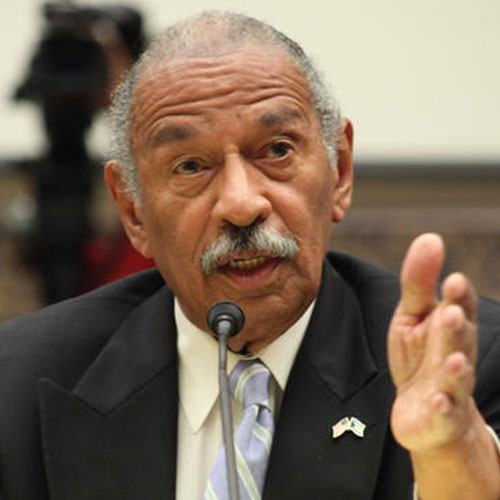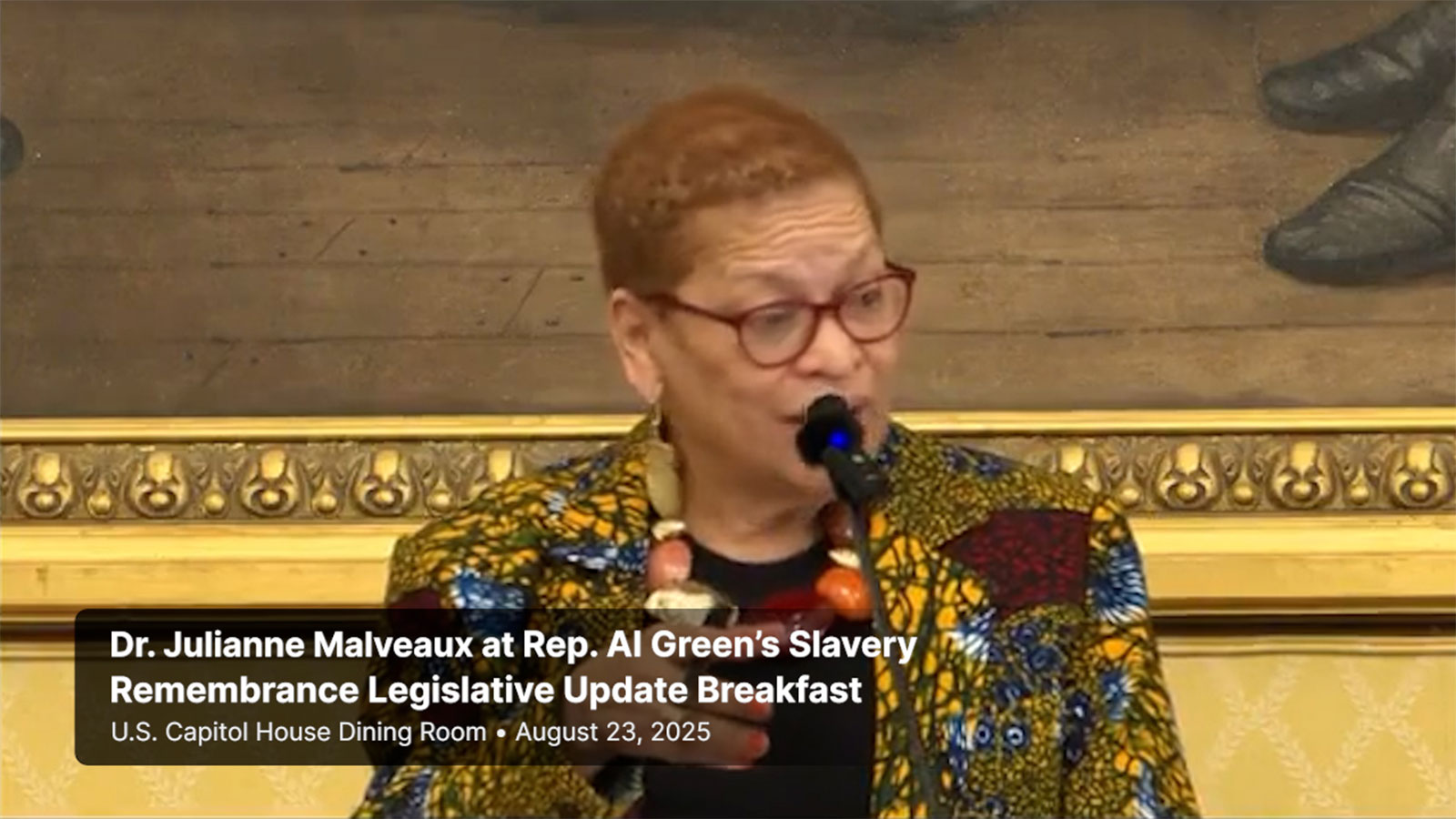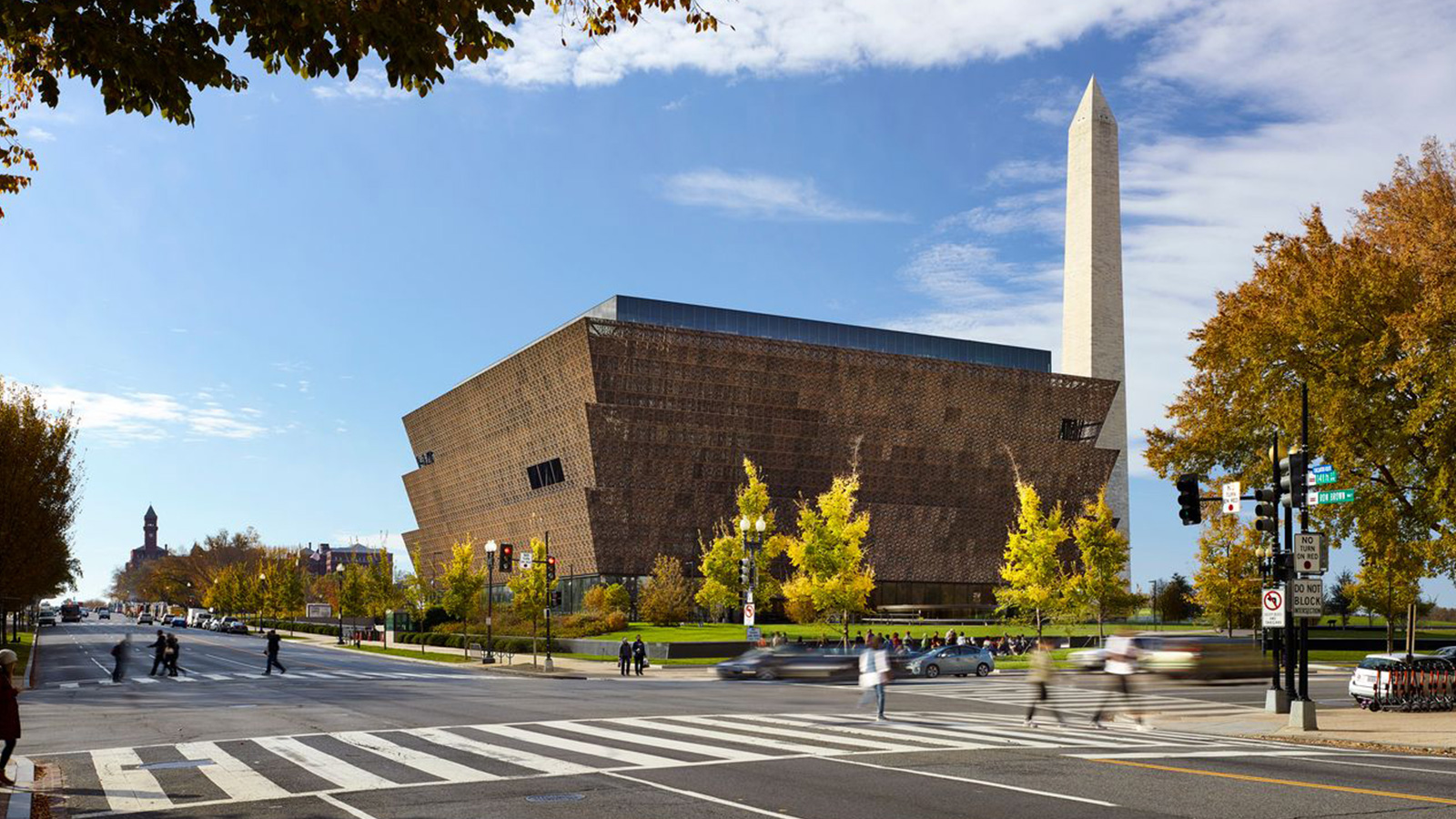Resources
Reparations FAQ’s, news, commentaries, videos, useful links and more

Cong. John Conyers first introduced H.R. 40 in 1989. It was historically referred to as the “Reparations Study Bill.” The new H.R. 40 is now being referred to as the “Reparations Remedy Bill”.
Find the answers to some of the frequently asked questions about reparations.
Go to sectionA consensus definition of reparations refers to a process of repairing, healing and restoring a people injured because of their group identity and in violation of their fundamental human rights by governments or corporations. Those groups that have been injured have the right to obtain from the government or corporation responsible for the injuries that which they need to repair and heal themselves. In addition to being a demand for justice, it is a principle of international human rights law.
Reparations for slavery is the application of the concept of reparations to victims of slavery and/or their descendants. There are concepts for reparations in legal philosophy and reparations in transitional justice. In the US, reparations for slavery have been both given by legal ruling in court and/or given voluntarily (without court rulings) by individuals and institutions.
Contrary to the conventional narrative, slavery is not America’s “original sin” it is America’s original crime, described by the United Nations as a “crime against humanity.” The reparations narrative today is fundamentally about a crime unpunished and a debt unpaid.
America owes an historical debt to Black and Brown people, and reparations means repaying that debt, a debt so large as to defy accurate accounting. There is no rug wide enough to cover up the magnitude of these crimes. Consider for a moment the essential nature of chattel slavery as was practiced throughout the Americas for centuries—that is, human beings as property, to be bought, sold, auctioned, used as collateral– the wholesale theft of vast amounts of wealth produced by coerced and oppressed black labor and re-enforced by an ethos of anti-black violence rooted in White Supremacy.
This violent crime, constitutes one of the most horrific mass abuses in the entire history of human civilization, a monstrous debt that has never been repaid and there’s never been reparatory justice for the victims of this crime, no restitution for the often whipped and flogged black bodies that built the foundations of US capitalism.
It is practically impossible to place a dollar value on this enormous theft, not only of wealth produced by uncompensated Black labor, but also the theft of cultural identity, religion, language, customs etc.
A fundamental principle and message embedded in the demand for Reparations is that there is and will be no impunity for the commission of any crime against humanity. In other words, whosoever commits a crime against humanity must know and expect that justice will be demanded of them —even if it takes two hundred years, and even if it is their successors and beneficiaries who are ultimately required to make recompense.
And so it is with the demand for Reparations for the multiplicity of genocides and crimes that have been committed against the indigenous peoples of the Caribbean and Latin America and against the sons and daughters of Africa by the nations, governments, and institutions of Europe and North America. Our campaign for Reparations sends a profound and invaluable message to all and sundry that there will be no impunity whatsoever for those who commit crimes against humanity !
A basic principle of the Reparations Movement is that the very demand for Reparations constitutes–in itself–an indispensable validation by African and African-descended people of our own precious humanity.
If Africans or Afro-descendants fail to demand that the present-day representatives and beneficiaries of those persons, institutions and nations that committed the most horrible crimes imaginable against our ancestors be held accountable and made to pay restitution, we would be implicitly sending a message to ourselves and to the world at large that we do not consider our ancestors (or ourselves) to be sacred beings imbued with inalienable rights and deserving of respect and justice!
The mere act of demanding Reparations is important, and is a critical component of the process that we must engage in as individuals and as a collective, a process of repairing ourselves and of reaffirming the value of our civilization and heritage.
The fusion of race and capitalism first materialized with the advent of the African slave trade in the late 17th century. Racism and its convergence with capital emerged concurrently with the 1600s oceanic trade routes. African enslavement resulted in enormous profits for the rising capitalist class in Europe and the USA in the 17th, 18th and 19th centuries.
This reparations idea has been recurring in the politics of the United States, from the 1865 Special Field Orders No. 15 (“Forty acres and a mule“) to the 2020 Democratic Party presidential primaries. The idea of reparations remains highly relevant.
The first known case of reparations for slavery in the United States was in 1783 to Belinda Royall in the form of a pension, and since then it has been and continues to be proposed and/or given in a variety of forms.
Forms of reparations which have been proposed or given in the United State by city, county, state, and national governments or private institutions include: individual monetary payments, settlements, scholarships, waiving of fees, and systemic initiatives to offset injustices, land-based compensation related to independence, apologies and acknowledgements of the injustices, tokenary measures (such as naming a building after someone) and the removal of monuments and streets named to slave owners and defenders of slavery.
Callie House (1861 – 1928) was a leader of the National Ex-Slave Mutual Relief, Bounty and Pension Association, one of the first organizations to campaign for reparations for slavery in the United States. House was born a slave in Rutherford County, near Nashville, Tennessee. At the age of 22, she married William House. They had six children, five of which survived. After William died, House supported her family by being a washerwoman.
House and Isaiah H. Dickerson traveled ex-slave states to gather support for the National Ex-Slave Mutual Relief, Bounty and Pension Association (MRB&PA). They visited black churches—one of the few places blacks could organize without white interference. MRB&PA was chartered August 7, 1897, with the goal of providing compensation to ex-slaves, mutual aid, and burial costs. At its peak, it claimed membership in the hundreds of thousands.
Despite lack of evidence, the federal Post Office Department accused slavery reparation organizations like MRB&PA of frauding their members. In 1899, the MRB&PA was forbidden to send mail or cash money orders. The Department of Justice opened an investigation of the MRB&PA. In 1901, Dickerson was found guilty of “swindling” but the conviction was later overturned. Upon Dickerson’s death in 1909, House became the leader of the MRB&PA. Despite interference with mails, the MRB&PA struggled on under House’s leadership.
The US Postal Service’s accusations of fraud culminated in 1916 with House’s arrest and subsequent sentencing to one year in prison in Jefferson City, Missouri. House’s arrest dampened the national reparations movement, which struggled on through local branches until the 1930s.
The Reparations Agreement between Israel and the Federal Republic of Germany was signed on September 10, 1952, and entered in force on March 27, 1953. According to the Agreement, West Germany was to pay Israel for the costs of “resettling so great a number of uprooted and destitute Jewish refugees” after the war, and to compensate individual Jews, via the Conference on Jewish Material Claims Against Germany, for losses in Jewish livelihood and property resulting from Nazi persecution.
West Germany paid Israel a sum of 3 billion marks over the next fourteen years; 450 million marks were paid to the World Jewish Congress. The payments were made to the State of Israel as the heir to those victims who had no surviving family. The money was invested in the country’s infrastructure, and played an important role in establishing the economy of the new state. Israel at the time faced a deep economic crisis and was heavily dependent on donations by foreign Jews, and the reparations, along with these donations, would help turn Israel into an economically viable country.
In 1980, under mounting pressure from the Japanese American Citizens League and redress organizations, President Jimmy Carter opened an investigation to determine whether the decision to put Japanese Americans into concentration camps had been justified by the government. He appointed the Commission on Wartime Relocation and Internment of Civilians (CWRIC) to investigate the camps. The Commission’s report, titled Personal Justice Denied, found little evidence of Japanese disloyalty at the time and concluded that the incarceration had been the product of racism. It recommended that the government pay reparations to the internees.
In 1988, President Ronald Reagan signed into law the Civil Liberties Act of 1988 which apologized for the internment on behalf of the U.S. government and authorized a payment of $20,000 (equivalent to $43,000 in 2019) to each former internee who was still alive when the act was passed. The legislation admitted that government actions were based on “race prejudice, war hysteria, and a failure of political leadership.” The U.S. government eventually disbursed more than $1.6 billion (equivalent to $3,460,000,000 in 2019) in reparations to 82,219 Japanese Americans who had been interned.
Since further injustices and discrimination have continued since slavery was explicitly legal in the US, reparations for non-slavery related injustices have also been called for alongside slavery-related reparations by black communities and civil rights organizations.
Some suggest that the U.S. prison system starting with the convict lease system and continuing through the present-day government-owned corporation Federal Prison Industries (UNICOR), is a modern form of legal slavery that still primarily and disproportionately affects black populations and other minorities via the war on drugs and what has been criticized as a school-to-prison pipeline.
In 2020, the call for reparations in the US has been bolstered by protests of police brutality and other cases of systemic racism in the US. Recently, in the US, a call for reparations for systemic racism, settler colonialism and Jim Crow segregation in the US has been made alongside calls for reparations for slavery.
Slavery, colonialism, imperialism and white supremacy, all, have negatively impacted people of African Descent as a group, as a people. But the responsibility to repair the damages done to people of African descent in the USA and around the world is not just a matter for states, governments and corporations to address.
The case for reparations is compelling. It rests on the pillars of moral responsibility, accountability, and justice that when fused together will begin to repair centuries of hurt and damage. The logic of reparations is rooted in historical truth, science, and public morality. The imperative of reparations is undeniable and incontrovertible.
All white people who have benefited in one way or another from the crimes of slavery bear a moral responsibility to support the mass movement for reparations as advocates, donors, activists, organizers, lobbyists, ambassadors, etc.
Reparations is about restoring and making whole a group of people who have endured unspeakable harm and damage. To those who say that reparations is difficult, a taboo political subject, the third rail of American politics, we say these are the people who have abandoned their principles, or who have lost the courage of their convictions.
The living legacy of enslavement is manifested in today’s society in persistent poverty and widening disparities in every socio-economic index (health, education, housing, unemployment etc.) and in the growing economic inequalities in both income and wealth. On average, a white family today has 10-13 times more wealth than a Black family. And, this huge advantage in white wealth is perpetuated through inheritance from one generation to another. The root cause of this obscene imbalance was slavery and its persistence today is the result of systemic racism and structural white supremacy.
This centuries-long theft of the wealth produced by enslaved black bodies has been facilitated and protected by white supremacy, an ideology based on lies and myths that has penetrated into the day-to-day functioning of every social, political, educational and legal institution in America….entrenched privilege and entitlements on the one hand and denial on the other, based simply on skin color.
Chattel slavery in the United States and the rest of the Americas is not a thing of the past. The legacy lives on today and it continues to adversely impact the lives of all of us, Black, Brown, White etc. It is not something that is foreign to us. We cannot ignore it, or wish it away. Up to 1868, Black people provided America with 246 years of free labor. America became and remained an economic superpower, due in large part to the contributions of Black America’s blood and sweat.
We often talk about the unpaid wages of slavery but we almost never talk about how free black labor benefitted even those who did not own slaves. The cotton merchants made higher profits because they bought cotton cheaply. The ship builders, the textile industry, the sugar industry, the international traders, etc., and every free person in America benefitted from the free labor of blacks which propped up the entire US national economy.
NAARC strongly affirms the right of all people of African descent in the U.S. to receive reparations, irrespective of when they arrived here or their country of origin. The historical fact is that centuries of enslavement, post-Emancipation racially exclusionary policies and practices, psychological trauma, racial oppression, violence and mass incarceration have severely underdeveloped and, in some instances, outright destroyed families and communities in Black America. As a result, both community and direct benefits, in whatever form or forms that are agreed upon, are necessary components of a reparatory justice settlement.
However, it is critical to recognize that direct benefits are insufficient to repair the underdevelopment and destruction of communities. Indeed, as expressed by NAARC’s Preliminary Reparations Program, “No amount of material resources or monetary compensation can ever be sufficient restitution for the spiritual, mental, cultural and physical damages inflicted on Africans by centuries of the MAAFA, the holocaust of enslavement and the institution of chattel slavery.”
We are, and always have been, an African people. We cannot afford to be distracted by misguided notions about who is entitled to reparations and in what form. Any attempt to draw lines between those who are the descendants of the pre-1865 enslavement era and those who followed, will come to no good end. It is a prescription for division and failure, which is a disservice to the multi-generational struggle for reparations.
There will be only one victor if people of African descent are distracted and divided; an amoral capitalist political-economy and white supremacist system which was responsible for the enslavement and centuries of oppression and exploitatation of our people will triumph, remain substantially intact, without making restitution for its crimes against humanity. In memory of our ancestors, NAARC is determined that this will not happen!
Individual payments as reparations is, for the most part, unfeasible, implausible, naïve and in many instances, downright reactionary. The proponents of this individualized approach are articulating a Black version of white nativism, a kind of black anti-immigration xenophobia. This approach will do little to close the racial wealth gap and will, instead, exacerbate income inequalities within Black communities.
The National African American Reparations Commission (NAARC) prefers a collective, community-based approach to reparations payments, one that is workable, planable, accountable and executed fairly and equitably….an approach that emphasizes the building of powerful community-based economic institutions that benefit the entire African-American community in a fair and equitable manner. This is a far more democratic approach when compared with the individual payments model.
Therefore, we renew the call for a National Reparations Trust Authority to be the repository, custodian and administrative body to receive monetary and material resources, allocated by offending parties, as restitution to repair the damages inflicted on the sons and daughters of Africans in America during centuries of oppression and exploitation.
This Authority would be comprised of a cross-section of credible representatives of reparations, civil rights, human rights, labor, faith, education, civil and fraternal organizations and institutions. It would be empowered to establish subsidiary Trust Funds to administer projects and initiatives in the areas of culture, economic development, education, health and other fields as deemed appropriate based on the demands in the Reparations program.
Accordingly, independent Black controlled structures like the Reparations Finance Authority recommended in NAARCs’ 10-point Reparations Program are imperative to receive various forms of resources to be allocated as community benefits to support social, economic, cultural and educational programs, projects and initiatives that enhance Black communities as a whole.
On January 3, 2017, at the opening of the 115th Congress of the United States , Cong. John Conyers introduced a revised HR 40 bill. The previous version was first introduced in 1989 and was historically referred to as the “Reparations Study Bill.” The new HR 40 is now being referred to as the “Reparations Remedy Bill”. Today, HR-40 is championed by Cong. Sheila Jackson Lee of Texas and co-signed by over 150 Congresspersons.
The recent protests across the United States have ushered in a national reckoning on structural racism — and a sea change in attitudes. A clear majority support the protests and believe that racism is a serious issue in this country and that addressing it can’t wait. Americans are now more eager than ever to pull back the curtain on institutions to see whether they have helped to advance or stall racial progress, and Congress is no exception. One bill in particular can demonstrate support for meeting this moment in a reasonable, rational, and compassionate way: HR 40.
The current social movement, the largest in US history, is in response to problems that are 400-plus years in the making — issues intractably tied to the enslavement of Black people in America. Americans are increasingly aware that there is no way forward from the current strife without addressing one of the nation’s most enduring crimes against humanity. HR 40 would establish a commission to investigate the legacy of slavery and its ongoing harms as well as come up with proposals to Congress for financial redress and repair.
HR 40 is simply a first and reasonable step toward reconciliation — it is a commitment to truth-telling, studying and coming up with ideas to treat the disease, rather than a commitment to the treatment itself. The bill has been introduced for 30 years — yet for 30 years, it has languished. If the protests have demonstrated anything, it is that immediate action can longer wait.
We can’t get back those years and wages that Black people lost while in bondage and unfairly behind bars. We can’t recover the lives lost to systemic anti-blackness and heinous racial terror. We can’t undo the trauma that has wreaked havoc on Black communities and bodies. But what we can do is pass HR 40. It is what the moment requires. It is an opportunity to start moving America out of this deep quagmire of inequality and to finally make it whole.
Established in April, 2015, the National African American Reparations Commission (NAARC) is a group of distinguished professionals from across the country with outstanding accomplishments in the fields of law, medicine, journalism, academia, history, civil rights and racial and social justice advocacy.
They are united in a common commitment to fight for reparatory justice, compensation and restoration of African American communities that were plundered by the historical crimes of slavery, segregation and colonialism and that continue to be victimized by the legacies of slavery and American apartheid.
Convenor of the NAARC is Dr. Ron Daniels, veteran civil and human rights activist and Distinguished Lecturer Emeritus, York College, City University of New York.
NAARC is dedicated to the memory of Queen Mother Audley Moore, mother of the modern-day reparations movement in the USA.
A Document for Review, Revision and Adoption as a Platform to Guide the Struggle for Reparations for People of African Descent in the U.S.
1. A Formal Apology and Establishment of a MAAFA/African Holocaust Institute →
2. The Right of Repatriation and Creation of an African Knowledge Program →
3. The Right to Land for Social and Economic Development →
4. Funds for Cooperative Enterprises and Socially Responsible Entrepreneurial Development →
5. Resources for the Health, Wellness and Healing of Black Families and Communities →
6. Education for Community Development and Empowerment →
7. Affordable Housing for Healthy Black Communities and Wealth Generation →
8. Strengthening Black America’s Information and Communications Infrastructure →
9. Preserving Black Sacred Sites and Monuments →
10. Repairing the Damages of the “Criminal Injustice System” →
The CARICOM Reparations Commission is a regional body created to establish the moral, ethical and legal case for the payment of Reparations by the governments of all the former colonial powers and the relevant institutions of those countries, to the nations and people of the Caribbean Community for the Crimes against Humanity of Native Genocide, the Trans-Atlantic Slave Trade and a racialized system of chattel slavery.
For more information click on– https://caricom.org/caricom-ten-point-plan-for-reparatory-justice/

Compensated emancipation was a method of ending slavery, under which the enslaved person’s owner received compensation in exchange for manumitting them. This could be monetary, or it could be a period of labor, an indenture. Cash compensation rarely was equal to the slave’s market value.





